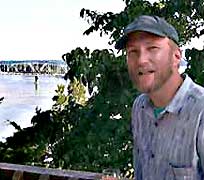 Dr. Robert Jacobson watches over the Missouri River
Dr. Robert Jacobson watches over the Missouri River
Big rivers like the Missouri River cannot be restored but simply rehabilitated. That's the opinion of Dr. Robert Jacobson, a research hydrologist on the staff of the U.S. Geology Survey's Columbia Environmental Research Center, who spoke at a Missouri State University seminar sponsored by MSU's biology department.
The Missouri River is an important one to rehabilitate because it drains one-sixth of the United States, has 10 million people on it and has the nation’s largest reservoir system, Jacobson said. Rehabilitation is what he thinks conservationists are doing to big rivers.
The Missouri River used to have wide channels with dynamic eroding and depositing of sediment before humans changed the river’s structure. Today, the river has narrow channels and is deeper and faster.
“Something like the Missouri River is really a human dominated landscape,” Jacobson said.
Approximately 100,200 acres of aquatic habitat and 67,800 terrestrial acres were lost when the river was narrowed by humans, Jacobson pointed out. Sediment also has decreased significantly from the year 1700 to now.
There was much more diversity in the river before it was narrowed. On the other hand, some of the most prosperous land in our country came from where the river was leveed off to make it narrower, Jacobson said.
Because of the man-made changes to the river over the years, the number of species in the river habitat has decreased. According to Jacobson, current studies show a decline in 24 native fishes and many birds.
The Pallid Sturgeon fish is federally endangered, but Jacobson says the fish is difficult to save because scientists have little information about its lifestyle. On the other hand, the threatened Piping Plover bird is easier to save because scientists have a greater knowledge of its habitat.
Flow and form are the determining factors in river restoration, but Jacobson thinks that flow restoration alone would be fairly unsuccessful in helping the habitat. In his opinion both channel form and flow need to be naturalized to rehabilitate habitat.
Jacobson defines restoration as the reestablishment of the natural structure and function of an ecosystem to pre-disturbance conditions while he considers rehabilitation as the recovery of some of the natural ecosystem structure.
Scientists have dealt with flow through experimental spring rises in the river that are intended to help the river’s habitat by building sand bars, connecting food plains and increasing offspring.
Jacobson said that experimental spring rises may not truly accomplish many of the goals thought to benefit the river’s habitat. As an example, he said that many sandbars were created by extremely large natural flows in 1997, but experimental flows would not be large enough to have the same effect.
His other criticism of rehabilitation is that native species will not necessarily come back. “If you build it,” he asks, “who will come?”






Comments